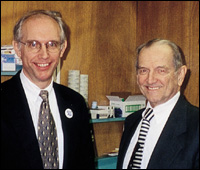
Am Fam Physician. 2000;61(7):1951

The bright golden logo on the cover of this issue announces the official milestone: It's AFP's birthday! And we're going to celebrate. This issue heralds the completion of AFP's 50th year of publication and marks the beginning of many more years of publishing. In addition to introducing a new series of evidence-based case studies in preventive medicine (see pages 1984 and 2239), this issue contains several commemorative features to celebrate AFP's anniversary.
While my affiliation with AFP extends over the past two decades, covering a significant part of the journal's history, it's nonetheless with humility that I write about the history of AFP, since so many other long-time friends of AFP could undoubtedly tell the story much better. Pictured above are two of them: Jay Siwek, M.D., editor of AFP, and his father, Stanley J. Siwek, M.D. What's so unique about this pair? You can find the answer by flipping to page 1974, where there's an editorial written by this father-son team.
Dr. Jay Siwek joined the staff of AFP as an associate editor nearly 20 years ago and assumed the role of editor after the retirement of his predecessor, John Rose, M.D., in 1988. But let's back up a little, to the beginning.
AFP started out as a journal under a different name: GP. In 1947, the American Academy of General Practice was founded, independently of the AMA Section on General Practice, which was established one year earlier. Mac Cahal, a lawyer who had been chief executive officer of the American College of Radiology, was hired by the AAGP's first Board of Directors as the Academy's executive director. The Board wanted to start its own journal and appointed Mac as its publisher.
Mac Cahal, having the vision to create a journal unlike others in the field—a journal that provided practical clinical reviews in a fresh, unfettered format—proved to have great foresight, as the journal was met with many accolades from the very start. For the sake of nostalgia, we've reproduced some of the letters Mac received in a commemorative “Yours Truly” section in this issue (see page 1995). And, for a sampling of the kind of practical clinical reviews that won the instant admiration of readers, see page 1952, which continues the year-long series honoring AFP's 50th year of publication.
Mac Cahal put together a medical editing staff for GP that included as the first editor Dr. Kenneth Albrecht, who died of a pulmonary embolism after a car accident shortly before the first issue went to press. He was succeeded by Dr. Walter C. Alvarez, who was a professor of medicine at Mayo Clinic and a highly renowned physician of his time. Dr. Hugh Hussey, dean of the medical school at Georgetown University, assumed the role of editor in 1951 and, after his departure in 1959, became a respected editor of JAMA. Dr. Arthur DeGraff, a cardiologist and professor of therapeutics at New York University, was editor of GP until 1962, when Dr. John Rose became editor. Dr. Rose, who also served as dean of the medical school at Georgetown University, had been associate medical editor since 1955.
After going through a short metamorphosis from GP to American Family Physician/GP, the journal acquired its current name, American Family Physician, in 1971.
That's the story of AFP, in a nutshell. The whole story would contain thousands of other characters: publishers; medical editors; editorial board members; authors; language artists; illustrators; graphic artists; circulation, reader services, production, marketing and advertising staff; printers and other production vendors; and hundreds of others who must remain unnamed, but to whom we owe our sincerest thanks and fondest wishes.